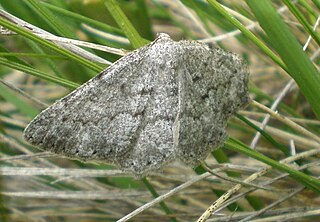
Hypercompe is a genus of tiger moths in the family Erebidae erected by Jacob Hübner in 1819.

Cyanopepla is a genus of moths in the subfamily Arctiinae. The genus was erected by James Brackenridge Clemens in 1861.
Neidalia is a genus of moths in the family Erebidae. The genus was erected by George Hampson in 1901.
Paracincia is a genus of moths in the subfamily of Arctiinae. The genus was erected by William Dewitt Field in 1950.

Rhabdatomis is a genus of moths in the subfamily Arctiinae. The genus was erected by Harrison Gray Dyar Jr. in 1907.

Elophos is a genus of moths in the family Geometridae.

Euryglottis is a genus of moths in the family Sphingidae. The genus was erected by Jean Baptiste Boisduval in 1875.

Euryglottis dognini is a moth of the family Sphingidae.

Elophos dognini is a moth of the family Geometridae. It is found in Spain, France, Andorra, Switzerland and Italy.
Agylla dognini is a kind of moth of the family Erebidae. It was described by George Hampson in 1900 and is found in Bolivia.
Josiomorphoides dognini is a moth of the subfamily Arctiinae first described by Hering in 1925. It is found in Colombia.
Cyanopepla dognini is a moth of the subfamily Arctiinae. It was described by Gustaaf Hulstaert in 1924. It is found in Paraguay and Brazil.
Pseudatteria dognini is a species of moth of the family Tortricidae. It is found in Ecuador.
Hypercompe dognini is a moth of the family Erebidae first described by Walter Rothschild in 1910. It is found in Brazil.
Idalus dognini is a moth of the family Erebidae. It was described by Walter Rothschild in 1910. It is found in Peru.

Lophocampa dognini, the Rothschild's marbled tiger, is a moth of the family Erebidae. It was described by Walter Rothschild in 1910. It is found in Peru.
Neidalia dognini is a moth of the family Erebidae first described by Walter Rothschild in 1909. It is found in French Guiana, Peru, Costa Rica and Hispaniola.
Paracincia butleri is a moth of the subfamily Arctiinae. It was described by William D. Field in 1950. It is found on Jamaica.
Rhabdatomis dognini is a moth in the subfamily Arctiinae. It was described by William D. Field in 1964. It is found in Mexico.






